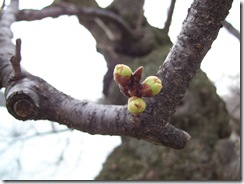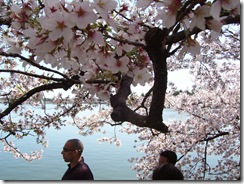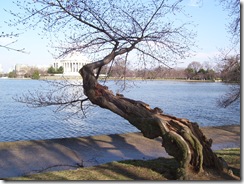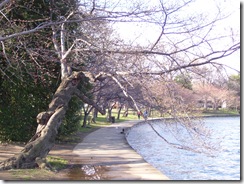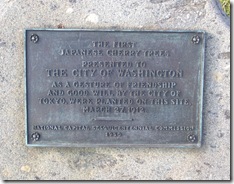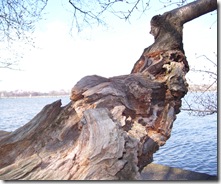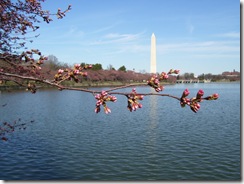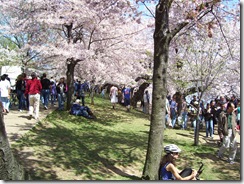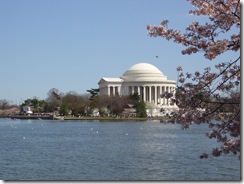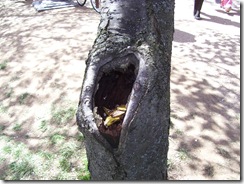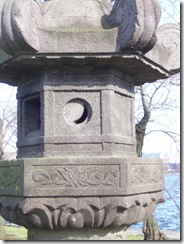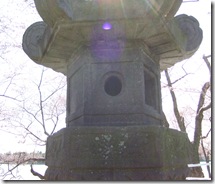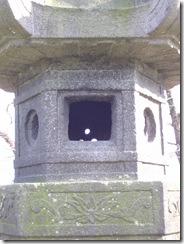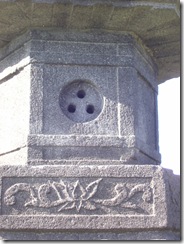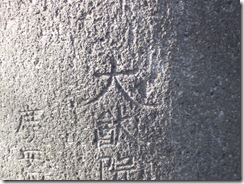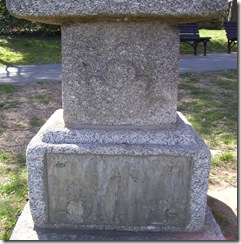« Marching Toward the Equinox | Main | JUNE VISITORS »
April 9, 2009
Cherry Blossom Gems
By Ron Paci
Craftsman at Large
Early bud, March 8
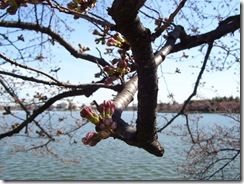
Extended florets, March 21
Just past peak, April 5
These are some of the original trees. They have a placid existence 346 days of the year.
The crowds don't come for the buds.
The blossoms draw the crowd.
And everything that comes with them.
-------------------------------------------------------------------
Magpie knowledge - that's what a Brit friend of mine said his college professor accused him of displaying; when he told me that I rejoiced in finding another kindred spirit. The implication being that his knowledge of the subject at hand is incomplete, and gained in an unstructured way, i.e. not from formal studying.
-------------------------------------------------------------------
Some interesting Magpie gems discovered during the cherry blossom project:
Two manmade objects placed among the Tidal Basin cherry trees, a Japanese stone lantern and a stone pagoda are probably the oldest objects outdoors in Washington. The lantern was 300 years old when it was presented to the city in 1958, sculpted in 1651 according to the press releases. The Stone Pagoda, a gift to the city by a private citizen, may date to the 12th century.
------------------------------------------------------------------
Washington, the city, and seat of the government, came into official being in 1800 when the capital was moved here from Philadelphia. There were a little over 10,000 whites, and a little over 3000 slaves here at the time. 'Washington,' the place, belonged to the Piscataway Indians before that. They went west.
Tokyo, the city, and the source of our cherry trees came into being in 1457. Before that, 'Tokyo,' the place, was populated with the ancestors of the new city of Tokyo. They brought along some traditions.
In Washington, cherry blossom interest dates to 1912. In Japan, well, back a ways...
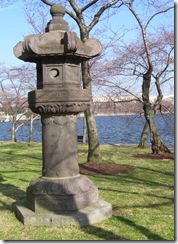 The stone lantern is a Buddhist object. Both lantern and Buddha appear in Japan in the 6th century. The first lanterns in Japan were made by Chinese craftsman.
The stone lantern is a Buddhist object. Both lantern and Buddha appear in Japan in the 6th century. The first lanterns in Japan were made by Chinese craftsman.
The ceremonial lantern lighting in Japan is a metaphor for banishing the darkness of ignorance and illusion; here in the nation's capitol we use it to celebrate the crowning of Miss Cherry Blossom Festival; she gets crowned with a $300,000 crown with 1,585 pearls set in a gold frame ringed with a band of ermine fur. She only wears it for a few ceremonial minutes because it's so damn heavy; then it's back to the vault.
The golden age of stone lantern making in Japan was in the 12th century; so, by their standard, the one they gave us, to commemorate post WWII friendly relations and to mark the 100th anniversary of our first trade agreement with Japan, was a relatively new model. Not that there's anything wrong with that.
The Eastern religions rely on symbols to bridge the weak human mind to the ultimate truth which is unknowable, indefinable, inexpressible in the language of men. Well, that gives one a lot of wiggle room. These stone sculptures are loaded with symbolism
There are 9 major categories of lantern styles and 75 subcategories. They started being used for non-religious ceremonies - tea rituals - in the 16th century and like anything Asian, it is a slippery slope into arcane, obscure and confusing, so a few magpie sparkles will suffice to get one's head above the crowd.
Our lantern's 8-feet high and weighs a couple tons. Everything on it means something. The hexagonal construction defines its type; there are seven named divisions bottom to top. The third section from the bottom is an inverted lotus leaf; top of the shaft another lotus leaf. Lotus is the flower of paradise, a symbol of purity.
The fire box has a crescent moon, a circle representing the sun, a square opening representing earth, and the three circles represents the triad of Buddhism.
The inscription on the shaft has been translated as:
This stone lantern is dedicated to Daiyuinden at the Toeizan Temple of Musashi Province this twentieth day of November of the fourth year of Keian by Matsuura-Shizunobu, Lord of Hizen.
What does that all mean?
'dedicated to Daiyuiden...' Daiyuinden: is the posthumous name of Tokugawa Iemitsu, the third shogun of his family's reign. The Japanese honor royalty with a posthumous name, in this case the name of his reign. Iemitsu was the grandson of the first Tokugawa shogun, Leyasu, who started the dynasty in 1603; his base of operations was Edo, Edo Castle, which became Tokyo, which is where our cherry blossoms came from.
Japan was a military dictatorship for 7 centuries, 1185 till 1867. The dictators were called shoguns, and their power was maintained by their samurai. Class lines were rigid: emperor, nobles, samurai, farmers, craftsman, merchants (parasites), entertainers, beggars, executioners. Rules were followed, and not incidentally, sword making became an art at this time. It was a period of isolation both in Japan and China.
In 1600, William Adams, a Brit seaman, sailing on a Dutch ship (the English and Dutch were allies against the Catholics, but we won't go down that road) was washed ashore and became the first Englishman in Japan and the basis for the James Clavell novel of feudal Japan: Shogun.
Later, in 1853, Commodore Mathew Perry and his steam powered black ships pulled into Tokyo Bay in July seeking trade with the Japanese and a safe harbor for our long reaching whaling ships. They 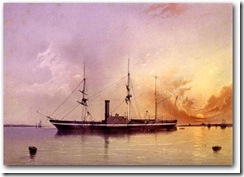 wouldn't let him in. And he refused to speak to low level dignitaries. Finally, after much discussion, the trade agreement paperwork was signed in March 1854; and we dealt with the Shoguns for another 13 years. The presentation of this lantern commemorated the 1854 agreement.
wouldn't let him in. And he refused to speak to low level dignitaries. Finally, after much discussion, the trade agreement paperwork was signed in March 1854; and we dealt with the Shoguns for another 13 years. The presentation of this lantern commemorated the 1854 agreement.
The Toeizan Temple, mentioned in the translation as the place where the lantern was dedicated, was built in 1651, the same year our lantern was sculpted, and is the burial place of the Tokugawa shoguns. The temple is in Ueno Park, Tokyo's first public park, and the site of the last battle of Tokugawa to hold onto power. He lost that battle, and in 1867, the Emperors are back in business.
The Musashi Province, where the Toeizan Temple is located, is the period name of area of Tokyo.
Year of Keian is the name of an era, 1648-1652.
Matsuura Shizunobu, who dedicated the lantern in 1651, was Lord of Hizen: Hizen is the period name of the southern most island of Japan. Nagasaki is here. The modern name of the Hizen area is Kyushu. Matsuura Shizunobu was the local warlord, daimyo, of the Hizen province and ruled from the famous Hirado Castle. This was the port of entry for the Jesuits in 1550, and the Dutch traders in 1600. The Hirado clan monopolized the Dutch trade, which caused no end of conflict; and Hizen is where William Adams died.
------------------------------------------------------------------
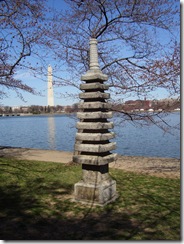 The park service marker describing the stone pagoda says it was given to a former D. C. Commissioner, Renah Camalier, by the mayor of Yokohama, Ryozo Hiranuma. Camalier later gave it to the city to place among the Tidal Basin cherry trees. And then, the Japanese rededicated it to the city of Washington. What's that all about?
The park service marker describing the stone pagoda says it was given to a former D. C. Commissioner, Renah Camalier, by the mayor of Yokohama, Ryozo Hiranuma. Camalier later gave it to the city to place among the Tidal Basin cherry trees. And then, the Japanese rededicated it to the city of Washington. What's that all about?
Until 1967, the District of Columbia was governed by three commissioners appointed by the president, two civilian commissioners, and a commissioner from the military corps of engineers. Camalier was named D.C. commissioner in 1952 by Truman, and he stayed on after Eisenhower took office in January 1953. It  was in '53 that Hiranuma visited Washington and gave a personal present to the 'mayor' of Washington. I haven't unearthed the circumstances of that occasion or the nature of their relationship, but when the present finally arrived in 4 or 5 crates at the Port of Baltimore four years later in May 1957, Camalier wasn't sure what it was. No longer commissioner, he passed the present, what ever it was, off to the city.
was in '53 that Hiranuma visited Washington and gave a personal present to the 'mayor' of Washington. I haven't unearthed the circumstances of that occasion or the nature of their relationship, but when the present finally arrived in 4 or 5 crates at the Port of Baltimore four years later in May 1957, Camalier wasn't sure what it was. No longer commissioner, he passed the present, what ever it was, off to the city.
And, as related on the marker at the pagoda, they turned it over to the Smithsonian guys to put it together.
The stone of the pagoda is not as fine as that of the lantern. The softer material has weathered, and the carvings
have lost definition. But some who studied it earlier say the buddhas carved on the sides of the base, and design are consistent with an earlier period than stated on the marker. A brass commemorative plaque has gone missing.
Posted by ronpaci at April 9, 2009 11:23 PM
